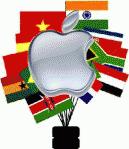
Apple today posted Q1 earnings that indicated that — despite wider problems in the European economy, and price and device competition from Android everywhere, it continues to make advances in international markets. Apple broke out sales in Greater China — which includes the Mainland, Hong Kong and Taiwan — on its balance sheet, which were up by 67% on the same quarter last year, and 26% on the last quarter, to $6.8 billion. And sales in Europe were up by 11% to $12.5 billion. Apple says that international sales overall, which also includes the wider Americas, Japan, and the Rest of Asia Pacific, were 61% of its overall revenues of $54.5 billion.
Given that Apple overall posted Mac sales that were some 21% down on a year ago, a lot of the growth in these markets is down to sales of iPhone and iPad devices. Indeed Apple noted today in its conference call that iPhone sales in China doubled over the last year, as it opened four more retail stores in the country as well.
To compare to last quarter, last quarter, it was Europe and Asia Pacific (outside of Japan) that dragged down both Apple’s year-on-year performance and sequential quarter performance. While Q4 revenues in the Americas rose by 43% to $13.8 billion; and 113% in Japan to $1.1 billion, Europe was up by only 8% on the year to $8 billion and Asia Pacific was up by 15% to $6.5 billion. Compared to the quarter before, they were respectively down 3% and 4%.
One big subtext to what is happening with Apple in international markets is the wider trend in smartphones. As smartphone growth continues to slow down in ever-more penetrated developed markets, the big focus for all handset makers is what is happening in later-adopting, emerging economies such as China, Brazil and India.
This is a segement that companies like Nokia, Samsung and many nameless-to-you-and-me Android makers have traditionally targeted with low-cost devices, and they are following through with that in smartphones, with devices under $100, and sometimes even under $50. Deloitte, in fact, projects that of the 1 billion smartphones that will be sold in 2013, half a billion of them will retail for less than $100.
Earlier this month, when Tim Cook visited China, a lot of speculation arose over whether Apple would ever develop low-end smartphones to compete with these. For now, Apple continues to tackle that segment with older versions of the iPhone, which cycle down to become the “low-end” devices in that range. But this is not just an emerging market issue: given the ongoing, wider economic problems even in developed markets like Europe, a low-cost handset strategy might not be a bad idea elsewhere, too.
Nevertheless, there is a persistent appetite for high-end devices, too, in markets like China with iPhone 5 sales in China topping 2 million in their first weekend on sale there in December — and of course that overall, 67% growth in revenues.
Apples to Apples, the company is doing well in iPhone and iPad sales, with record sales numbers this past quarter. But sill, when you compare it to sales of competitors’ handsets, the writing on the wall is a bit different. Yesterday, Kantar Worldpanel put out its smartphone sales figures for the 12 weeks that ended December 23. There, Apple’s iPhone range was the top seller in the U.S. and Japan but played second fiddle to Android in every other major market that Kantar regularly surveys.
More important is the rate of growth. In Kantar’s figures for smartphone sales in Europe, Apple gained only 0.2% market share compared to 6.3% in the U.S. Specific countries are seeing bigger declines: Great Britain, it noted, was down by 1.7%, Spain was down by 1.8% and Australia — another big market for smartphones, one that Apple hotly contested Samsung for in the patent courts — iOS devices were down by 3.4%. As a point of comparison, Android handset sales rose by 13.1% in Europe, according to Kantar’s figures.


